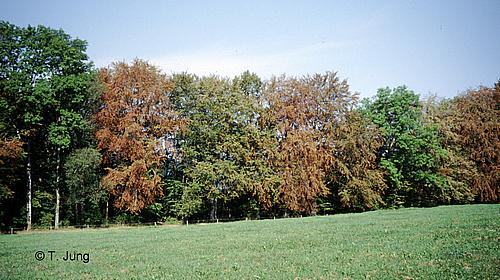Source(s): Kim Coder
The trees that line our city streets and properties have endured decades of stress from:
- heat and cold,
- root-crimping sidewalks,
- smog,
- insects and disease.
Unfortunately, many older trees may have met their match in this year’s severe drought.
Arborists are warning the intense drought will likely do the most damage to our grandest trees. “There is a public perception a lot of times that those are just untouchable, so nothing can hurt them,” said Kim Coder, professor of tree health care at the University of Georgia’s Warnell School of Forest Resources. “It’s actually the opposite. The old trees are much easier to stress out and damage than younger trees.”
It’s too early to tell how extensive the loss will be. Steady rain over the next few months would ease trees’ suffering. “But if we remain in a droughty cycle, this spells disaster for a lot of these trees,” Coder said. In addition to the drought, a late spring freeze and waves of 90+ degree scorchers this summer has made this a stressful year for trees.
The scope of this year’s damage won’t become clear until May. Dr. Coder also warned that an ice storm or cold front in the next few months could send weakened limbs tumbling. And spring rains could make trees more likely to topple. Roots shrink away from the soil in a drought. When it finally does rain, winds can cause them to pull out of the ground.
For some trees, the drought may spur a decline over two or three years. That decline could be aided by:
- ambrosia beetles
- root-rot fungus
- mistletoe.
In urban areas, the drought just makes a tree’s life harder. Concrete and asphalt stress trees by confining roots and branches as they reach for water, light and soil. Many cities have passed tree ordinances to stop people from removing trees.
Homeowners should be thinking about replacing trees as there is likely to be a large-tree loss from this year’s drought. Fall and winter are the right time to plant new trees, even if it’s not clear when their older neighbors are going to succumb. Watering restrictions make planting somewhat difficult, but reused or “gray” water from the house should be enough for a new tree.
Here are a few things tree lovers can do to help their trees survive:
- no heavy fertilizer or pesticides use,
- add mulch 2 to 4 inches deep,
- do not overwater.
Resource(s): Landscape Plants for Georgia
Reviewer(s):
- Maria E. Abreu, CEA- Gwinnett County, The University of Georgia College of Agricultural and Environmental Sciences.
- Chuck Cornwell, Program Assistant- Forsyth County, The University of Georgia College of Agricultural and Environmental Sciences.
Center Publication Number: 255
- Growing Grass in Shady Locations - September 24, 2013
- Drought Damages Stately Trees - September 23, 2013
- Protect Landscape Trees from Drought Injury - September 23, 2013
